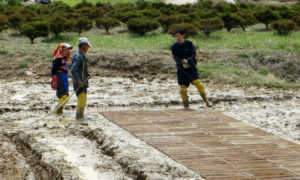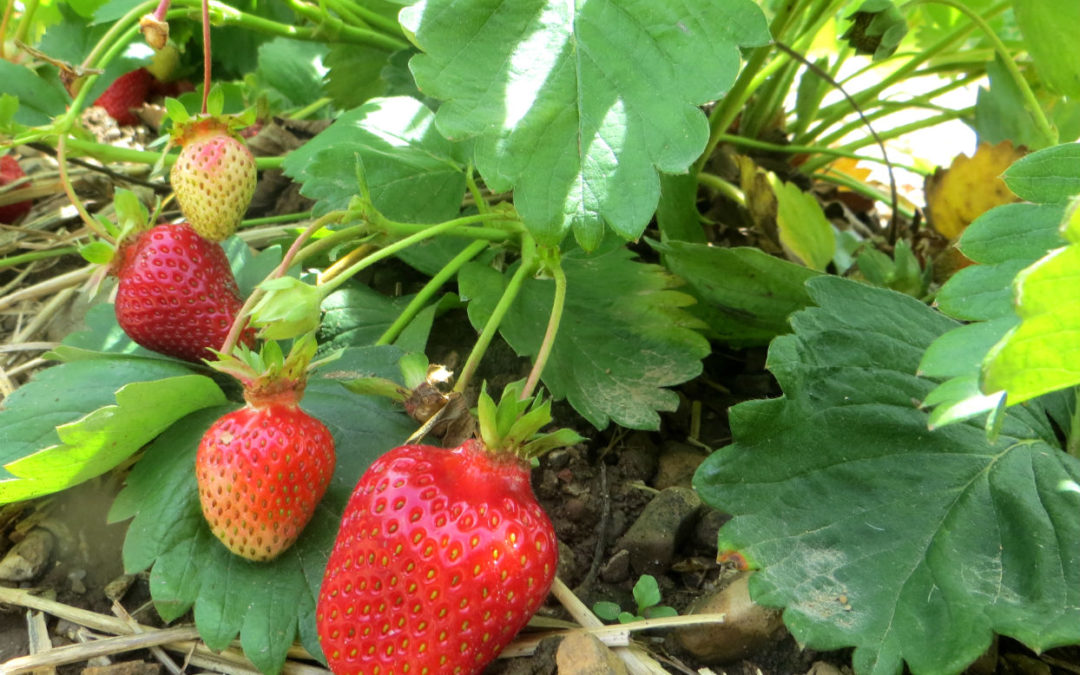
When I was making my spring break Korea travel plans, I asked Beverlee Einsig of Korean Heritage Tours to help me find options to learn about Korean agriculture. Beverlee, a stellar guide with her Korean counterpart, Mr. Chae, had taken our family on a homeland tour in 2010. An agricultural tour was a request that they had never gotten, but Mr. Chae found us a unique Korean opportunity.
South Korea has a climate similar to the mid-Atlantic states in the United States with temperatures reaching up to 70 degrees Fahrenheit in mid-April dropping into the 40’s at night. Summer temperatures reach into the 90’s with high humidity. In mid-April the farms are already buzzing, and farmers are beginning to make a little money to support their operations, while preparing for their summer crop season.
Farmer Cho’s strawberry operation
Our destination was a strawberry farm owned by 60-year-old Farmer Cho, the youngest farmer in the 37-acre farm community of 30 farmers in Yangpyeong, about a one-hour drive east of downtown Seoul on the Han River. Farmer Cho grows rice, strawberries and beef cattle on his two-and-a-half-acre farm. All three of his products are certified organic by the Korean government, as are all of the farmers’ products in this small valley.
Visitors are invited to tour his farm, fill (but not overfill) a one-quart container with strawberries, and eat as many strawberries as desired — all for $18 per person. Housed under extra-insulated hoop houses for those brisk early and late season days, the ever-bearing strawberry season begins in mid-March and ends in October. Rows of strawberry plants are grown on foot-high mounds that have been wrapped in plastic. Strawberries drip down the sides but never touch dirt, so they are ready for immediately popping into one’s mouth. Overhead and under-row sprinkler systems are fed by an on-site well, and each of the three hoop houses support their own discreet bee colony. The larger strawberries are picked by his customers. Farmer Cho picks the smaller berries and makes them into refrigerator jam, which is sold for about $9/pint.
Farmer Cho’s strawberries are nourished by his 63 head of beef cattle. Since land is at a premium in Korea, there are no pasture-fed beef on his farm! Farmer Cho regularly cleans out the pens, places sawdust on the floors, and returns the cattle to the pen. The cattle are fed the greens and hulls from last year’s rice crop, which is augmented by a purchased grain mixture. The 100% organic manure material is used to fertilize his strawberry crop, keeping the circle of inputs and outputs tight.
The Korean staple: Rice

Korean farmers building the hoop house over rice starts
Farmer Cho’s rice season had not started, but a neighboring farmer was preparing his starts. Rice seeds were placed in square starter boxes. A hoop house was being constructed with what appeared to be the farmer’s son who had returned from the city to assist his aging parents.
Since the rice plots appear to be small, little equipment is needed to grow the crop, which was especially fortuitous since their mini-tractor was stuck in foot-deep mud!
The starts will be planted in May with harvest in early October. Korea’s rice growing season is through the summer with upwards of 20 inches of rain over the three month wet season. Paddies are flooded to reduce weeds, but organic rice production may require hand weeding, since herbicides are not used.
I continued to enjoy my stash of strawberries the rest of our trip, savoring each drip of sweetness, knowing that I had experienced strawberry heaven!
Kathryn Gardow, P.E., is a land use expert and owner of Gardow Consulting, an organization dedicated to providing multidisciplinary solutions to building sustainable communities. Kathryn has expertise in project management, planning, and civil engineering, with an emphasis on creating communities that include food production.


Hi,
Appreciate if you can provide details on how to go Farmer Cho’s Strawberry Farm.
When is the best period to go?
Thanks,
Ashley
I went in April 2012 and was driven by a driver that spoke Korean and English. I had arranged my trip through another tour guide. My driver had never been on a farm. Farmer Cho does not speak English. His farm was east of Seoul in the Yang-pyeong valley. Since it is now 3 years since I went and much of the Seoul suburbs are under pressure to develop, I do not know if there is still farming in the valley. I would contact a reputable tour company and see if they can help you. His strawberry picking operation is similar to American “agri-tourism.” I was able to eat as much as I wanted and could take home one quart for about $20.